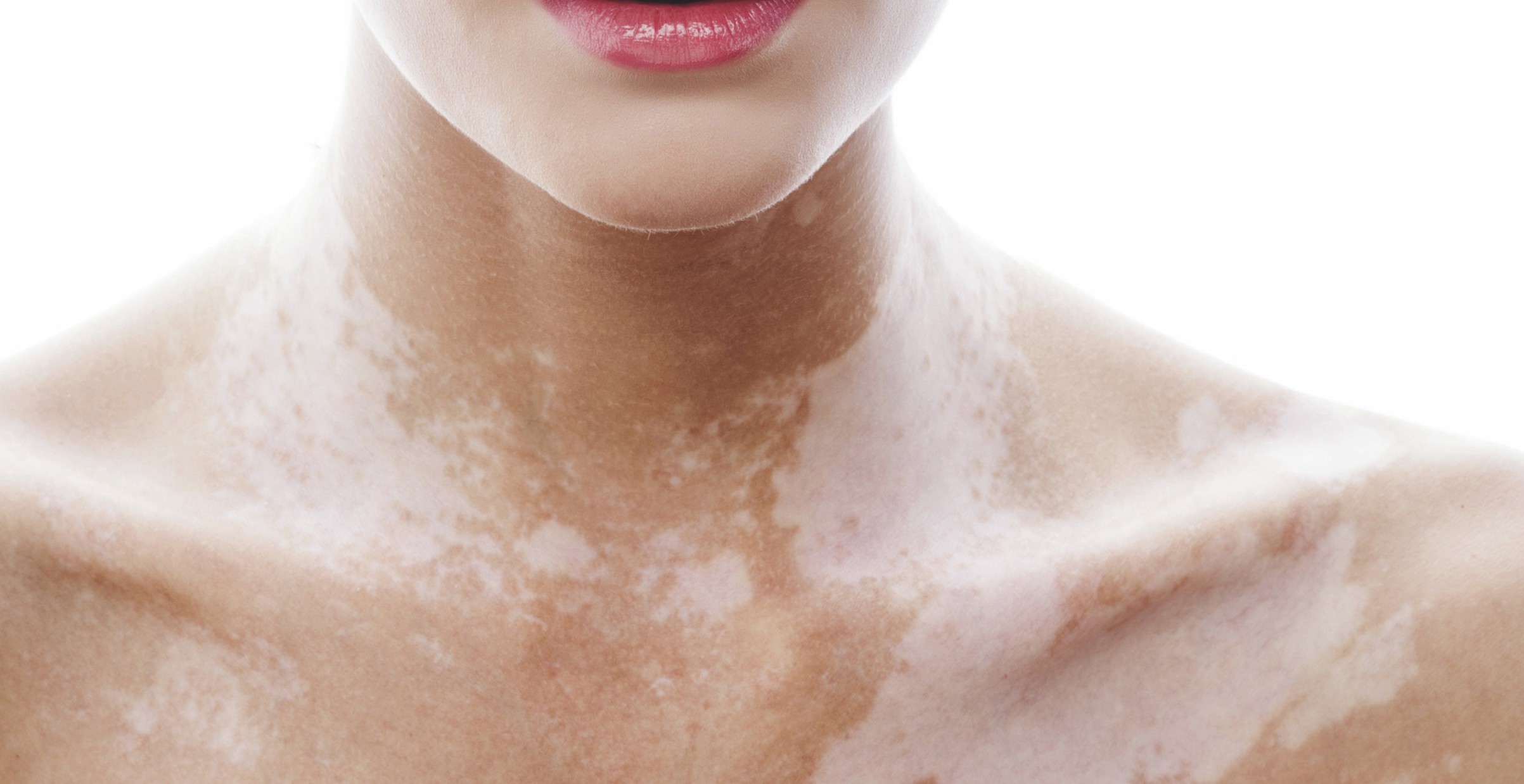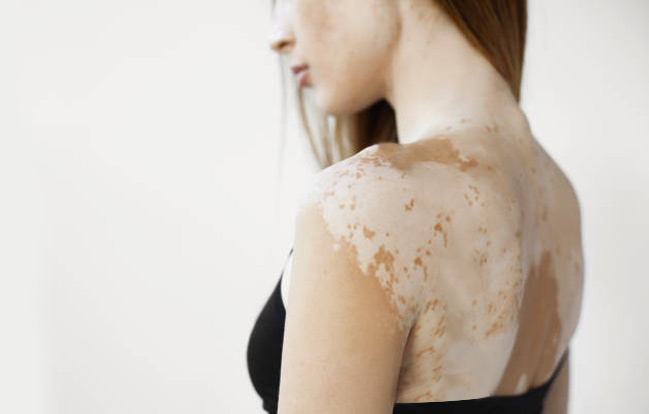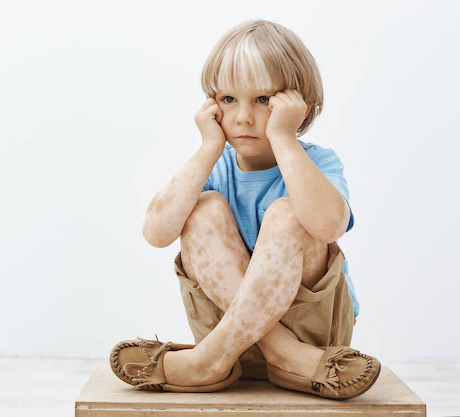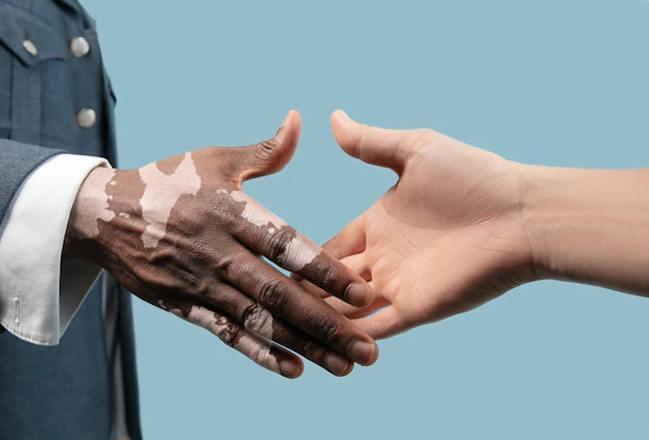What is vitiligo ?
We usually take our skin’s pigmentation for granted till we either lose it or have too much of it. Vitiligo or leucoderma is a pigment disorder in which there is loss of skin color leading to milky white patches on the skin. People of all races and ethnicities have Vitiligo.

Fill up the form
OR
What are the symptoms of Vitiligo?
People who develop vitiligo usually first notice white patches or spots on their skin. The skin remains normal textured, though some people experience itching in areas where the white patches are forming.
The white patches are more obvious in sun-exposed areas, including the hands, feet, arms, legs, face, and lips. Other common areas for white patches to appear are the armpits, groin and around the mouth, eyes, nostrils, navel and genitals.
Vitiligo in children is more common in girls than boys and starts with the segmental pattern. Koebnerization is frequently seen in children. Koebnerization is the development of white patches at sites of injury or trauma. Children experience frequent skin trauma during normal play. A family history of white patches is observed in 10% of adults. In contrast 12% to 35% is observed in children. Further adults with white patches are usually found to be suffering from a number of autoimmune diseases like diabetes, thyroiditis and alopecia areata. In contrast children are usually healthy.

Focal Vitiligo
In this pattern the spots or patches are limited to one or only a few areas

Segmental Vitiligo
Sometimes the white patches develop only on one side of the body, thus called segmental Vitiligo

Generalized Vitiligo
For most people who have Vitiligo, the white patches occur on different parts of the body in a bilateral pattern.
What is the course of vitiligo?
Will the white patches spread over time? Will they get larger? Will the patches come on the face? These are questions which are most frequently asked. The answer is not so simple. In many cases, white patches do spread slowly over time. This however is not true in every case. There is no certain way of knowing whether the white patches will progress or not.
The course and severity of pigment loss differ with each person. In many cases vitiligo begins in a small area. Over time other spots may appear while existing spots may grow larger. Some people notice that their vitiligo may stay the same for years or even decades and then suddenly new patches may occur. Occasionally vitiligo patches may re-pigment spontaneously all by themselves with no treatment whatsoever. Many people with vitiligo do notice this happening at some point in their lives.
What are the causes of vitiligo?
Despite advanced research, medicine is still trying to figure out the exact cause of Vitiligo. Scientists have not completely understood the disorder and there are numerous theories. However a genetic predisposition or susceptibility to vitiligo exists in most people who develop vitiligo.
Autoimmunity
Vitiligo is an autoimmune disorder in which the immune system sees the persons own melanoyctyes as foreign bodies and mistakenly attacks and destroys them. It can also be attributed to an abnormally functioning nervous system which may produce substances that injures melanocytes.
Genetics
It is found that people with a genetic predisposition are more likely to suffer from vitiligo. In about 10% of families where a person has vitiligo the condition is seen in another family member. Though no one else in your family may show signs of vitiligo it is still possible that it is passed on genetically.
The most likely reason for this is that genes are inherited in a random fashion from both parents, so only sometimes will the genes which make a person susceptible to vitiligo come together in the same person. Those who do not inherit a complete set of the abnormal genes are unlikely to develop the disorder. Those people who do inherit a complete set may also need some other factor to trigger the vitiligo patches to appear. In this way vitiligo genes can pass through several generations of a family without anyone actually developing vitiligo.
Oxidative stress
Vitiligo can be caused because of oxidative stress in which there is an over-accumulation of hydrogen peroxide in the skin. Every person develops hydrogen peroxide in the skin, as a result of natural biological processes. An enzyme called catalase normally breaks down the hydrogen peroxide in the skin into water and oxygen. However, some people with vitiligo may have a problem manufacturing, using or delivering catalase to the skin.
Certain chemicals
The most common chemical that can induce white patches on the skin is para-phenylene diamine (PPD) in hair dyes. As PPD can also be found in black socks and footwear, the white patches may also affect the feet. Chemically induced white patches are also caused due to contact with para-tertiary butyl phenol (PTBP) found in adhesive bindi, cleansing and cosmetic products or in deodorants. The white patch initially presents at the site of application but can spread beyond the area as well.
Stress
Emotional stress, grief and traumatic events have been found to trigger vitiligo. The melanocytes are more susceptible to the damaging chemicals produced during emotional stress.
Hormonal changes
Hormonal phases like puberty, pregnancy, menopause, thyroid abnormalities, uncontrolled diabetes, polycystic ovarian syndrome can trigger vitiligo in people who are susceptible.
Skin Trauma
Scratches or common wounds or serious lesions from accidents, or severe sun burns can trigger vitiligo.
Diet
Diet, nutrition and digestive disorders may play a role in the destruction of melanocytes. Deficiencies of iron, vitamin B12, folate, copper and zinc have been associated.
What are the complications of vitiligo?
Other than the white patches on the skin, there are no other physical symptoms of Vitiligo. The patches of Vitiligo tend to sunburn more easily.
Vitiligo by itself does not lead to other conditions. However there are other autoimmune conditions which may arise in Vitiligo patients like thyroid disorders, diabetes, alopecia areata, pernicious anemia and lupus.
What Is The Psychological Impact Of Vitiligo?
In the 1960s Vitiligo was considered by Jawaharlal Nehru to be one of the three major medical problems in India in addition to leprosy and malaria. Even today in conservative families it is common to consider affected individuals or members of their family as unfit for marriage.
Women with Vitiligo are often discriminated against in marriage. If they develop Vitiligo after marriage, it can be grounds for divorce. Hence it is life-changing even though it is neither contagious nor life-threatening.
Those affected and their families face social stigmatization leading to low self-esteem, anxiety, embarrassment, anger and even serious depression. This can happen regardless of the extent of the illness, especially when exposed areas such as face and hands are affected.

Are there any myths surrounding vitiligo ?
Because of the stigma attached to the disease and limited understanding of its causes till today there are many myths that surround white patches.
Myth 1 – White patches are caused by consuming milk over fish or by eating anything that’s white in color
This is far from the truth and there is absolutely no scientific basis to this theory. Some are advised to completely avoid white colored food including milk. Apart from the trauma of having to suffer from white patches, patients are further imposed with unnecessary diet restrictions. This makes the patient live in fear and constant guilt for not being able to follow diet restrictions. Furthermore it can make the patient suffer from dietary deficiencies and in fact worsen the white patches. In reality Vitiligo has no connection with diet nor does it have any impact on the severity of this condition

Myth 2 – White patches are caused because of a curse. Touching a person with white patches or eating food cooked by the person will make it spread to others.
This is also not true. By nature, Vitiligo is merely a pigment disorder and does not influence the physical or mental abilities. Vitiligo is not contagious by nature therefore cannot be transmitted through touch, sharing personal items, saliva or intercourse. It is not related to disorders such as leprosy or cancer.
It is time to shun these old school misconceptions. Those who look down upon patients with white patches are more in need of help than the people suffering from it.

How skin specialists diagnosed vitiligo in Chennai?
When you approach a skin specialist for vitiligo treatment in Chennai, they first diagnose it. They go through your medical history and then analyze your skin health. They also use a wood lamp for getting a better look at your skin. This lamp lets them see the infected areas of this disease.
If your dermatologist finds even a small symptom of vitiligo, they may recommend you for a blood test. Since it’s an autoimmune disease, people who are suffering from this disease can suffer from problems like the throid. Blood tests help you find thyroid disease.
Once they provide you with a diagnosis, your doctor will ask you whether you wish to cure this disease and will suggest the best treatment for vitiligo in Chennai.
How to Prevent Vitiligo?
You can prevent vitiligo in several ways such as self-care, consuming a healthy diet, home remedies, and more. No matter which method for treatment for white patches you want to go with, you should discuss the same with your dermatologist. They will give you a suggestion based on your condition.
You can even use sunscreen to prevent vitiligo. Make sure the sunscreen that you use is broad spectrum and also water resistant. All you need to do is apply sunscreen properly and then also reapply for at least two hours or even more. Those who are sweating or swimming can use sunscreen at least for every two hours. You also need to wear those types of clothes that are capable of shielding your skin from the sunlight. You should not use sunlamps and tanning beds.
Did You Know?
Scientists found out that a molecule in black pepper, called Piperine has the potential to stimulate a uniform pigmentation in the skin and produced results which were cosmetically better than conventional therapies.
What are the treatment options for vitiligo?
For many people, the appearance of Vitiligo spells doom. Almost everyone begins to imagine the worse. However it is important to note that today there is more research and more vitiligo treatment options available than ever before. In addition to topical applications and melanin stimulating oral medications, therapies like PUVA, narrow-band UVB, lasers, skin grafting and pigment transplantation and the use of immunomodulators have been developed.
Dr. Health’s Re-pigmentation therapy consists of a combination of therapies.
Why Choose Us For Vitiligo Treatment In Chennai?
Precision in Diagnosis
Every white patch does not mean vitiligo. Being a leading centre for vitiligo treatment in Chennai, we investigate thoroughly. This coupled with the fact that we have the best doctor for vitiligo treatment in Chennai ensures that every diagnosis is precise and accurate.
Expert Skin Consultant
Our vitiligo specialist in Chennai is Dr. Pranjal Shamsher who has three decades of experience treating skin disorders. She has crafted a multi-therapy approach that is superior to other white patches treatment that have been previously done.
Advanced Vitiligo Treatment Methods
Bringing some of the most advanced and effective dermatological diagnostic technologies to our patients is our top priority. Before establishing a diagnosis, we conduct a thorough dermatec analysis of the patient’s skin. Our specialist uses the most advanced vitiligo treatment methods to determine the patients; skin disorders.
Nutritional Advice
In addition to our top-tier white patches treatment, we also give nutritional and dietary advice to our patients. So that the skin disorder can be dealt with effectively.
Latest vitiligo Treatment Methods
As a premier skin specialist for vitiligo treatment in Chennai, we have incorporated all the vitiligo related latest techniques and technology into our system.
Our Patients Reviews
I have been undergoing treatment for white patches on my skin with Dr. Health Clinic since I was in school. Over the years there has been tremendous success and improvement. My skin has healed and the white patches have 95% gone. I am still associated with Dr. Health and still undergoing the treatment but results are fantastic. Very very happy satisfied.
my 22 year daughter has large vitiligo spots over her entire body including her face. we have been to so many doctors allopathic, homeopathic, ayurvedic but no results. Then one day our neighbor lady who was already on treatment with Dr. Health told us about this treatment and good results in her case after using medicines from Dr.Pranjal. We immediately rushed to her and after consultation we have built lot of hope that our daughter got cured of vitiligo. Finally we started the treatment. Within first fifteen days we saw lot of redness over her entire patches which we confirmed as a good sign. We the saw brown dots over her face, stomach and leg patches and month after month she got normal skin at least I can say 70% by the end of seven months.
I had 10 to 12 white patches on my legs. I was unable to wear shorts. I took one year treatment for vitiligo from Dr. Pranjal shamsher clinic in hsr layout and all patches are gone, now only 1-2 spots are remaining. She is very experienced and knowledgeable. Some of my relatives also taking vitiligo treatment with her. She gives solutions to all ur skin problem. it’s really good and you can consult them for all ur problems and for the best results. I prefer all Dr Health clinic for their all-skin problems.
when you take vitiligo treatment you want it to work. This is only expectation. I am happy to say that vitiligo treatment worked well. I had white patches on my eyelids and on finger tips. In the start it was slow, but then skin colored dots started coming and the patches got covered. I did not have any side-effects. Vitiligo Treatment is very effective.
Doctor is good. 50% of my anxiety went away in the first consultation itself. I have started vitiligo treatment only a few weeks back but I have a good feeling about this treatment. Vitiligo Treatment is simple to follow and for a busy person like me it’s a bonus.
Hello I am having your vitiligo treatment, my reference WHF2108. With your medicine, there is remarkable improvement in white patches, many black dots have started appearing and this is giving me confidence that this can be cure. Thank you very much mam for such good and side effect free treatment for vitiligo.
Frequently Asked Questions for Vitiligo Treatment
Dr. Pranjal Shamsher is the first Skin Doctor in Bangalore to offer natural, non-surgical and non-invasive treatments for skin disorders. She is a Registered Medical Practitioner (Registration No A-6516) and a true pioneer in Skin-Friendly Treatments.
Dr. Pranjal Shamsher is the first Skin Doctor in Bangalore to offer natural, non-surgical and non-invasive treatments for skin disorders. She is a Registered Medical Practitioner (Registration No A-6516) and a true pioneer in Skin-Friendly Treatments.







